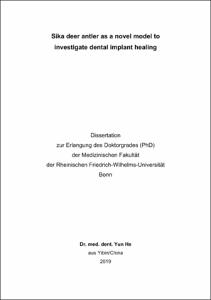Sika deer antler as a novel model to investigate dental implant healing

Sika deer antler as a novel model to investigate dental implant healing

| dc.contributor.advisor | Bourauel, Christoph Peter | |
| dc.contributor.author | He, Yun | |
| dc.date.accessioned | 2020-04-25T16:24:40Z | |
| dc.date.available | 2020-04-25T16:24:40Z | |
| dc.date.issued | 14.02.2019 | |
| dc.identifier.uri | https://hdl.handle.net/20.500.11811/7694 | |
| dc.description.abstract | The rapid growth and periodic regeneration of antlers make Sika deer a good and less invasive alternative model for studying bone remodelling. In this study, we developed a special loading protocol for dental implants inserted into deer antlers and analysed the bone reaction around dental implants under immediate loading (IL) and unloaded conditions until and how far osseointegration took place. The aim was to reveal changes in the structure and density of antler tissue during the healing phase, and observe the biomechanical properties of the implant and the surrounding antler tissue. Six healthy 4-year-old male captive bred and tamed Sika deer (Cervus nippon) were utilised in this study. Two implants per antler were inserted. One implant was loaded immediately via a self-developed loading device, the other was submerged and unloa¬ded as control. IL implants were harvested after different loading periods. The unloaded implants were collected after the shedding of antler. Specimens were scanned in a μCT scanner and the density of antler tissue around the implants was measured. Further¬more, samples were fixed, immersed, photopolymerised and parall¬elly cut in 100 to 200 μm thick sections. After grinding, sections were stained using tolui¬dine blue and evaluated under light microscope. Moreover, finite element (FE) models were generated from the μCT data by using FE software package. A vertical force of 10 N was applied on the implant. The mean values of maximum displacements, stresses and strains were compared and statistically analysed. The results showed that the density of antler tissue around the implants increased as the loading time increased. This finding was histologically confirmed by the good osseointegration that was observed in unloaded and loaded specimens. Besides, antler tissue displayed a similar healing process to human bone. After shedding the antler, the density of antler tissue remained in a similar value in all specimens. The maximum values of displacements and stresses in the implant and stresses and strains in antler tissue were significantly different among unloaded models and between loaded models. In one antler, all the biomechanical parameters of loaded model were significantly higher than those of unloaded model of the same animal (P<0.05) and wider distributions were obtained from loaded model. It can be concluded that implants inserted into Sika deer antler might not disturb the growth and the calcification process of antler and the use of Sika deer antler model is a promising alternative for implant studies that does not require animal sacrifice. | en |
| dc.language.iso | eng | |
| dc.rights | In Copyright | |
| dc.rights.uri | http://rightsstatements.org/vocab/InC/1.0/ | |
| dc.subject.ddc | 610 Medizin, Gesundheit | |
| dc.title | Sika deer antler as a novel model to investigate dental implant healing | |
| dc.type | Dissertation oder Habilitation | |
| dc.publisher.name | Universitäts- und Landesbibliothek Bonn | |
| dc.publisher.location | Bonn | |
| dc.rights.accessRights | openAccess | |
| dc.identifier.urn | https://nbn-resolving.org/urn:nbn:de:hbz:5n-53565 | |
| ulbbn.pubtype | Erstveröffentlichung | |
| ulbbnediss.affiliation.name | Rheinische Friedrich-Wilhelms-Universität Bonn | |
| ulbbnediss.affiliation.location | Bonn | |
| ulbbnediss.thesis.level | Dissertation | |
| ulbbnediss.dissID | 5356 | |
| ulbbnediss.date.accepted | 08.02.2019 | |
| ulbbnediss.institute | Medizinische Fakultät / Kliniken : Poliklinik für Parodontologie, Zahnerhaltung und Präventive Zahnheilkunde | |
| ulbbnediss.fakultaet | Medizinische Fakultät | |
| dc.contributor.coReferee | Wahl, Gerhard |
Dateien zu dieser Ressource
Das Dokument erscheint in:
-
E-Dissertationen (2056)




